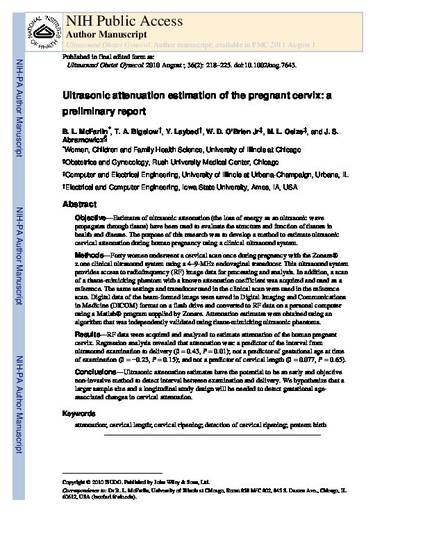
Estimates of ultrasonic attenuation (the loss of energy as an ultrasonic wave propagates through tissue) have been used to evaluate the structure and function of tissues in health and disease. The purpose of this research was to develop a method to estimate ultrasonic cervical attenuation during human pregnancy using a clinical ultrasound system. Forty women underwent a cervical scan once during pregnancy with the Zonare® z.one clinical ultrasound system using a 4–9-MHz endovaginal transducer. This ultrasound system provides access to radiofrequency (RF) image data for processing and analysis. In addition, a scan of a tissue-mimicking phantom with a known attenuation coefficient was acquired and used as a reference. The same settings and transducer used in the clinical scan were used in the reference scan. Digital data of the beam-formed image were saved in Digital Imaging and Communications in Medicine (DICOM) format on a flash drive and converted to RF data on a personal computer using a Matlab® program supplied by Zonare. Attenuation estimates were obtained using an algorithm that was independently validated using tissue-mimicking ultrasonic phantoms. RF data were acquired and analyzed to estimate attenuation of the human pregnant cervix. Regression analysis revealed that attenuation was: a predictor of the interval from ultrasound examination to delivery (β = 0.43, P = 0.01); not a predictor of gestational age at time of examination (β = − 0.23, P = 0.15); and not a predictor of cervical length (β = 0.077, P = 0.65). Ultrasonic attenuation estimates have the potential to be an early and objective non-invasive method to detect interval between examination and delivery. We hypothesize that a larger sample size and a longitudinal study design will be needed to detect gestational age-associated changes in cervical attenuation.
Available at: http://works.bepress.com/timothy_bigelow/1/

This is a manuscript of an article from Ultrasound in Obstetrics & Gynecology 36 (2010): 218, doi:10.1002/uog.7643. Posted with permission.